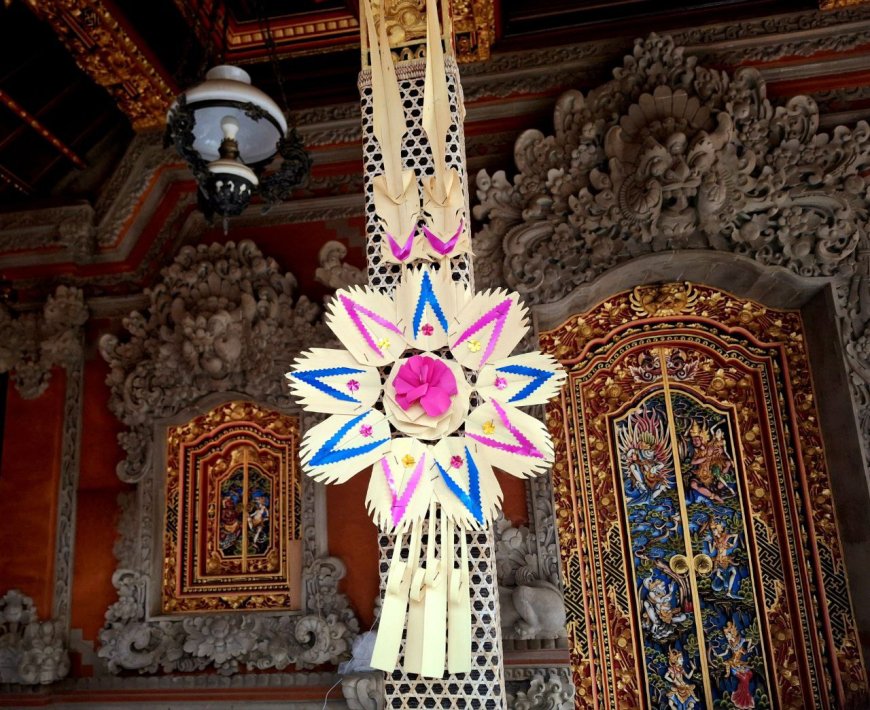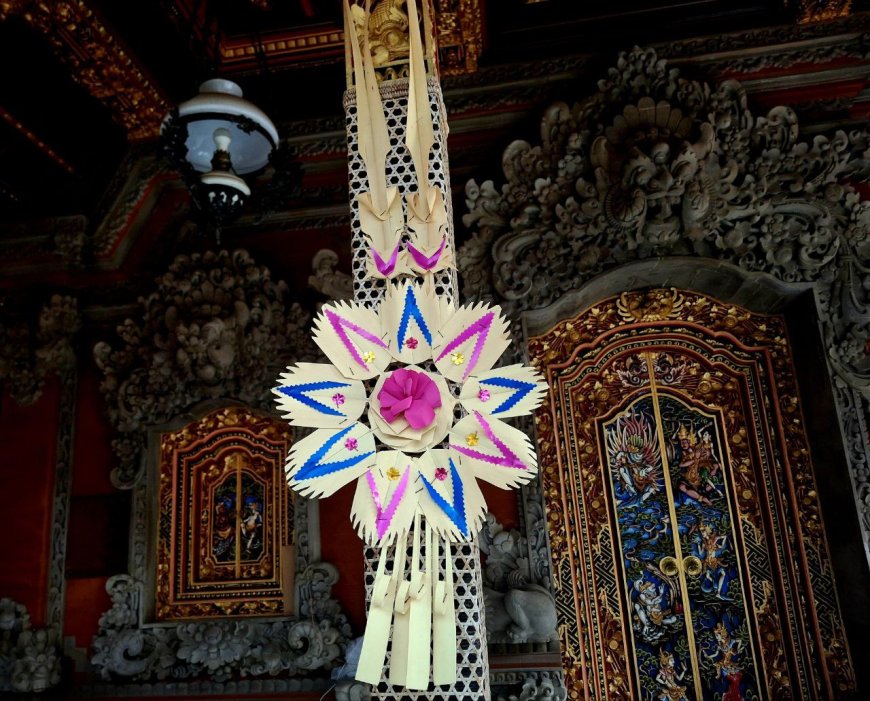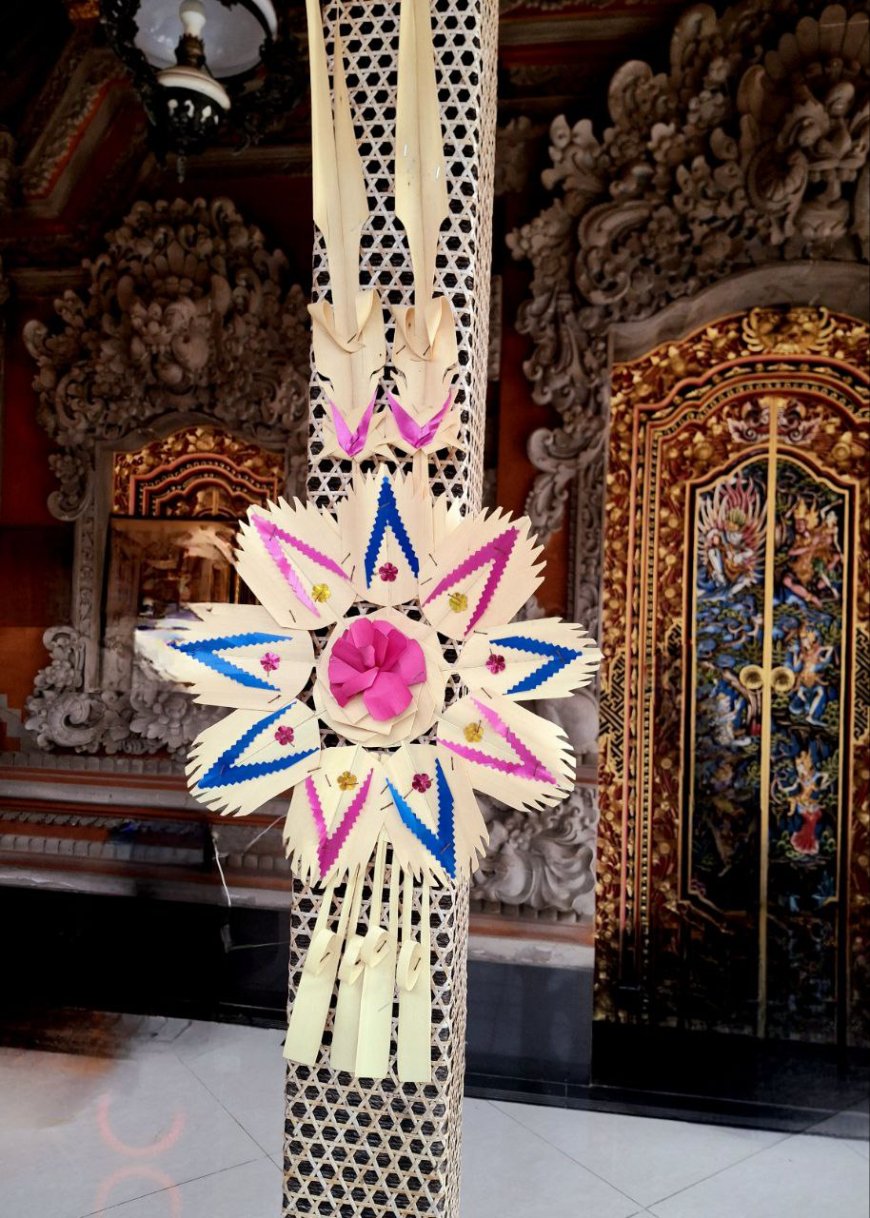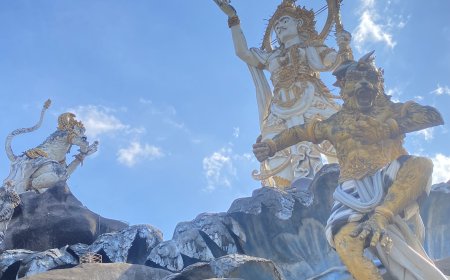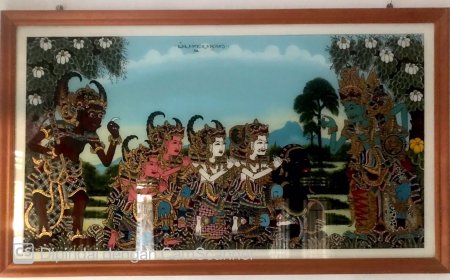Jejaitan Tamiang: Symbol of Life Cycle and Spiritual Meaning on Kuningan Day
Tamiang is one of the most distinctive elements in the celebration of Hari Raya Kuningan. Tamiang is round like a shield beautifully knitted from janur, symbolizing a shield used in warfare, as well as a symbol of self-protection. The round shape also reflects the symbol of Dewata Nawa Sanga, the guardian deities of the nine cardinal directions, and depicts the wheel of nature or the chakra of life that continues to rotate.
Hari Raya Kuningan is one of the holy days in Balinese Hindu tradition celebrated 10 days after Hari Raya Galungan. Kuningan marks the end of the Galungan series of celebrations, which are meant to honor ancestors and invoke blessings from the gods and protection for Balinese Hindus. On this day, Balinese Hindus believe that their ancestors return to kahyangan (the realm of the gods) after previously descending to the world on Galungan Day. Hari Raya Kuningan has a deep meaning in the spiritual life of Balinese Hindus. On this day, Hindus perform prayers to ask for safety, peace, and prosperity. Kuningan is also a time for Hindus to be grateful for the gifts that have been given by the gods and ancestors during their time in the world, which are considered to bring blessings and protection. Prayers and ceremonies are performed in homes, temples, and shrines, with the aim of invoking safety from bad influences and maintaining spiritual balance. The palinggih of all buildings (pelangkiran) is filled with hangings, tamiang, and kolem.
The word "tamiang" comes from "tameng," which means a means of protection or shield. In a spiritual context, tamiang symbolizes protection from attacks, both physical and mental, in the macrocosmic and microcosmic realms. For the Balinese, life in the real world is a battlefield in Bhuwana Agung (the macrocosmic realm), while the "inner war" takes place in Bhuwana Alit (the microcosmic realm). The inner warfare, which takes place in the heart, is considered the most powerful and never-ending "greatest war," often defeating humans. In the face of this inner warfare, one needs to protect oneself with tamiang, which is manifested in the form of self-control or mastery of the senses. The ability to control oneself reflects an awareness of one's true identity and nature (uning, meaning 'knowing' or 'aware'). This is the essence of the celebration of Hari Raya Kuningan (kauningan). On this day, devotees worship Dewa Indra, the manifestation of Ida Sang Hyang Widhi Wasa, who is the ruler and controller of the senses (the ten enemies within man). During Rahinan Kuningan, people are reminded to "let go and leave" worldly things through controlling the senses to get closer to God.
The Kuningan Day Celebration, tamiang is installed in the corners of houses and temples. Tamiang, seen from its round shape, is also often understood as a symbol that symbolizes Dewata Nawa Sanga, which is the manifestation of Ida Sang Hyang Widhi Wasa who guards or controls the nine directions of the wind. The nine gods are Vishnu, Sambhu, Iswara, Maheswara, Brahma, Rudra, Mahadeva, Sangkara, and Shiva. Tamiang also represents the ever-rotating cycle of life, likened to the wheel of nature or "cakraning panggilingan." This emphasizes that life and the universe move in repetitive patterns or inevitable cycles, such as birth, growth, death, and rebirth. The symbol reminds people of the importance of living in harmony with natural law, where if people fail to follow natural law, they will be crushed by the ever-rotating wheel of life. Natural law refers to the rules or balance of nature that must be respected and followed by humans. If one fails to follow the laws of nature, for example, by acting against the balance of nature, not taking care of the environment, or living unbalanced, then they will be "crushed" or adversely affected by the imbalance. This can be interpreted as an experience of life's hardships, suffering, or even destruction due to not respecting the cycle of life and the laws of nature.
As one of the essential elements in the Kuningan Day ceremony, tamiang is not merely a decoration but also a symbol in religious rituals that require precision and skill in its creation. To deepen the understanding of tamiang, here is a detailed description of how to make jejaitan Tamiang.
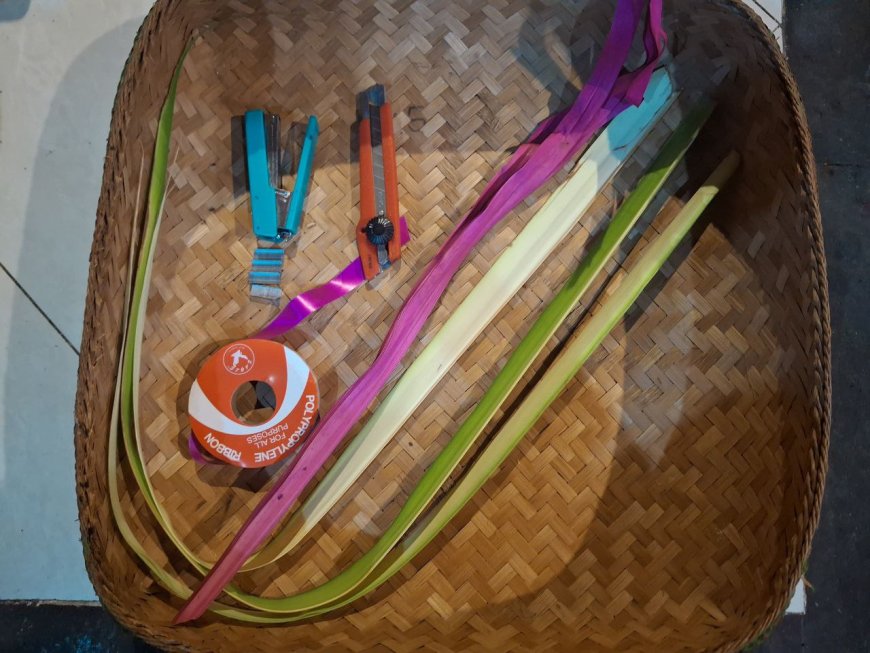 Tools and Materials for Making Jejaitan Tamiang (Source: Personal Collection)
Tools and Materials for Making Jejaitan Tamiang (Source: Personal Collection)
Before making the tamiang weaving, the tools and materials needed are as follows. Tools and Materials Needed:
- Janur (Young Coconut Leaves): Janur is used as the main material to create the frame and decorations of the tamiang.
- Scissors and Knife: A knife is used to cut the janur into the desired shapes and sizes. Scissors are used to cut the Japanese ribbon as an ornament for the tamiang.
- Stapler or Staples: Used to stitch or fasten the folded janur to keep it strong and neat.
- Japanese Ribbon (optional): To enhance the tamiang weaving in certain parts if desired.
After understanding the tools and materials needed, the next step is to explain the tamiang-making process. The stages of making the tamiang weaving require precision, patience, and mastery of good weaving techniques. This process begins by creating a sturdy base, followed by adding various decorative elements that hold symbolic meanings. Each step must be done carefully so that the final result is not only visually beautiful but also reflects the spiritual philosophy and values embodied in the tamiang itself.
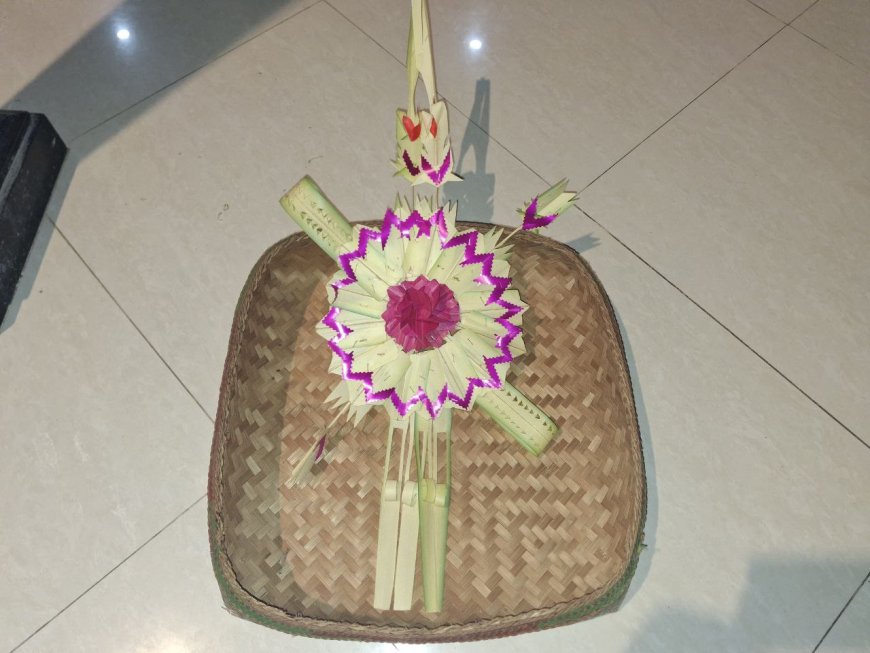 Worked Tamiang Results (Source: Personal Collection)
Worked Tamiang Results (Source: Personal Collection)
Steps to Make Tamiang:
1. Preparing the Janur : Choose high-quality janur (young coconut leaves); use fresh and flexible ones to ensure they are easy to shape. Cut off the hard base and remove any stiff leaf sheaths. Next, separate the leaf blades, take a few blades, clean and tidy them up. Ensure there are no torn or damaged parts.
2. Creating the Base Circle of Tamiang : Take one long janur blade, then cut and fold the janur into a circular shape to form the base of the tamiang. The size of this circle should be adjusted to the overall size of the tamiang you wish to create. Once the circle is formed, use a stapler or staples to join the ends of the janur so the circle remains stable. Make sure the fastening is tight enough to prevent the circle from coming apart. This base circle will serve as the foundation for the entire structure of the tamiang.
3. Forming Flower Patterns on the Edge of Tamiang : After the base circle is formed, the next step is to create a flower-like decoration on the edge of the circle. Take several blades of janur and cut them to the desired length. Fold the janur outward from the circle using repeated folding techniques that result in a petal-like pattern. To keep these petals in place, stitch them with a stapler or staples at each fold. Arrange them evenly so the tamiang circle is surrounded by symmetrical flower petals. As a note, to make the tamiang more attractive, it’s common to add color accents to the petal edges, though this is optional. You can use janur that has been dyed with bright colors, for example, pink as seen in the flowers in the image.
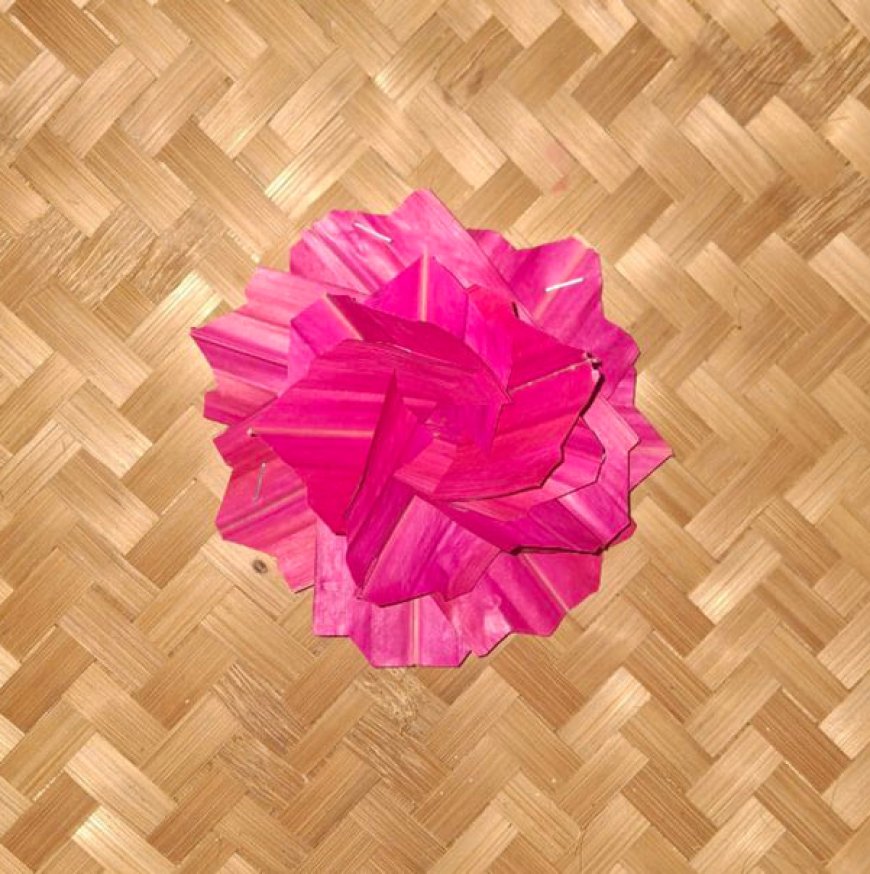 Flower Decoration (Source: Personal Collection)
Flower Decoration (Source: Personal Collection)
4. Creating and Adding Ornaments Around the Tamiang Base Circle : After the petal decoration is complete, it’s time to add ornaments around the tamiang. These ornaments can take on any form according to individual creativity and are placed around the base circle. To create them, take a piece of Japanese ribbon, fold it, and match the outer parts of the ribbon together. Then cut diagonally and repeat this process as needed. Once the ornament is ready, attach or sew it neatly around the base circle. This ornament will complement the tamiang and provide balance to the overall design.
5. Making Decorative Ends or Tails of Janur : The next part is to create the decorative ends or tails of janur that dangle at various points of the tamiang. Take several longer blades of janur and make decorative cuts on the ends. These can be in the form of spirals, arrows, or more intricate folds. Fold the janur and place it at several points on the base circle, usually at the top or sides, to give the tamiang a dynamic look. Use a stapler or staples to join and secure these decorations firmly to the base circle.
6. Assembly and Structural Reinforcement : After all parts (base circle, flower petals, central ornament, and decorative ends) are created, assemble all elements together properly. Use a stapler or staples to secure each element neatly and tightly. Ensure that all parts are in the correct position and are not loose. Double-check the entire tamiang and make adjustments if any part is uneven or loose.
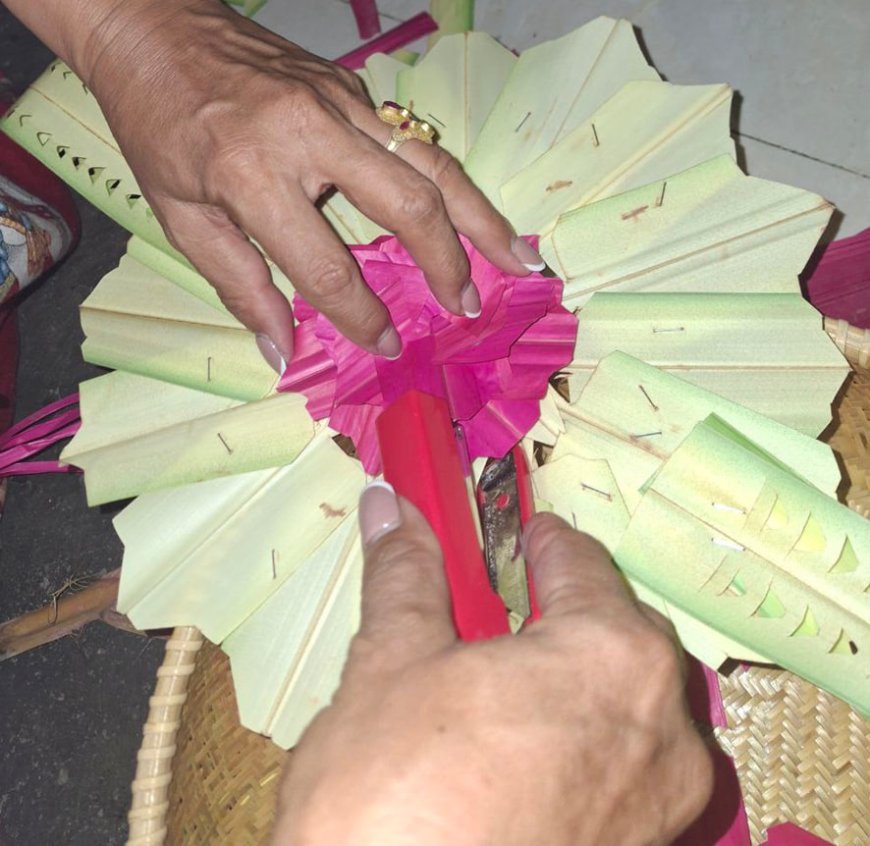 Joining Each Component with Staples (Source: Personal Collection)
Joining Each Component with Staples (Source: Personal Collection)
7. Finishing and Detailing : Perform a final check to ensure that all parts are arranged neatly and symmetrically. If there are any janur blades that are too long or untidy, trim them with scissors. Add additional details if needed, such as more color accents or decorative folds in specific parts to enhance the beauty and appeal of the tamiang.
As a conclusion, making tamiang not only requires skill in weaving janur but also involves an understanding of the philosophical meanings embedded in it. Each part of the tamiang, from the circular shape to the added decorations, symbolizes the cycle of life, balance in nature, and spiritual protection. In the Kuningan celebration, tamiang serves as a symbol reminding Balinese Hindus of the importance of self-control and harmony with the laws of nature. Thus, tamiang is not merely a work of art but also a representation of profound religious values.

















































